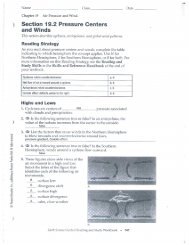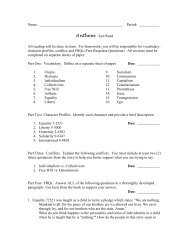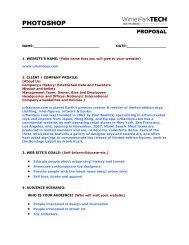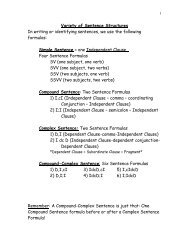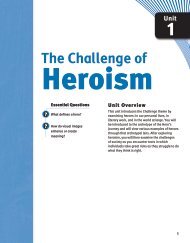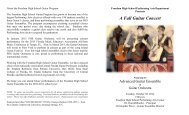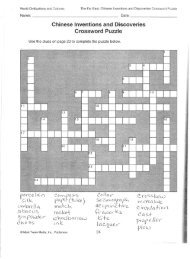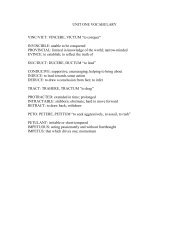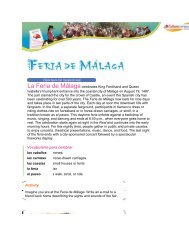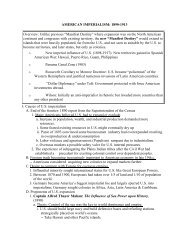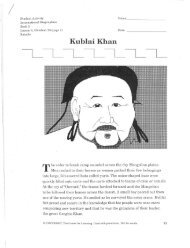Chapter 27 Empire and Expansion, 1890-1909 In the years after the ...
Chapter 27 Empire and Expansion, 1890-1909 In the years after the ...
Chapter 27 Empire and Expansion, 1890-1909 In the years after the ...
You also want an ePaper? Increase the reach of your titles
YUMPU automatically turns print PDFs into web optimized ePapers that Google loves.
Dewey’s May Day Victory at Manila<br />
1. Americans went to war with great enthusiasm.<br />
2. The US Army was comm<strong>and</strong>ed by Civil War officers <strong>and</strong> unprepared for war in <strong>the</strong> tropics <strong>and</strong><br />
vastly outnumbered by <strong>the</strong> Sp. Army in Cuba. Sp. Navy seemed to be better than <strong>the</strong> US’s <strong>and</strong><br />
except for Br. (now more a US ally) Europe favored Sp.<br />
3. As Under Secretary of <strong>the</strong> Navy, Theodore Roosevelt took advantage of <strong>the</strong> secretary’s absence to<br />
cable Commodore George Dewey, who was comm<strong>and</strong>ing <strong>the</strong> Asiatic Squadron in Hong Kong,<br />
telling him to attack <strong>the</strong> Philippines if war started. McKinley later confirmed <strong>the</strong> order.<br />
4. On 5/1/98 Dewey sailed into Manila Bay <strong>and</strong> attacked <strong>the</strong> antiquated Sp. Fleet. The Sp. lost <strong>the</strong><br />
battle <strong>and</strong> almost 400 men (No US sailors died.).<br />
5. Dewey had defeated <strong>the</strong> Sp. Navy, but he couldn’t take Manila, so he had to wait for troops from<br />
<strong>the</strong> US.<br />
6. O<strong>the</strong>r countries sent warships to “protect <strong>the</strong>ir nationals” in <strong>the</strong> Philippines. Dewey almost went to<br />
war with Germany, but <strong>the</strong> Br. were friendly.<br />
7. Troops finally arrived <strong>and</strong> Americans worked with Filipino insurgents led by Emilio Aguinaldo,<br />
who had been brought from exile by Dewey, to defeat <strong>the</strong> Sp.<br />
8. Events in <strong>the</strong> Philippines made America convinced that <strong>the</strong>y needed Hawaii as a coaling station.<br />
Hawaii was willing to cooperate, America wanted Hawaii, <strong>and</strong> Congress annexed it.<br />
9. Hawaiians became citizens in a US territory.<br />
The Confused <strong>In</strong>vasion of Cuba<br />
1. Despite his protests that his fleet would be destroyed, Sp. ordered Admiral Cervera to take his<br />
ships to Cuba.<br />
2. Americans on <strong>the</strong> Eastern seaboard expected to be invaded <strong>and</strong> panicked.<br />
3. Cervera sailed in <strong>the</strong> harbor at Santiago, Cuba <strong>and</strong> was bottled up by <strong>the</strong> American fleet.<br />
4. US government decided to send an unprepared army across Cuba to drive Cervera out.<br />
5. Theodore Roosevelt was <strong>the</strong> principal organizer of a group of cowboys, hearty characters, ex-polo<br />
players, <strong>and</strong> ex-convicts who were led by Leonard Wood. They became known as <strong>the</strong> Rough<br />
Riders<br />
6. <strong>In</strong> June 1898 amid much chaos <strong>the</strong> army sailed from Tampa <strong>and</strong> l<strong>and</strong>ed near Santiago.<br />
7. Fighting occurred on July 1 between <strong>the</strong> US <strong>and</strong> Sp. troops. The Rough Riders were very involved<br />
<strong>and</strong> TR evidently thought it was great fun!<br />
Curtains for Spain in America<br />
1. As <strong>the</strong> American army closed in from <strong>the</strong> rear, a protesting Admiral Cervera was ordered to fight.<br />
As he expected his fleet was destroyed, (500 Sp. Deaths to 1 American)<br />
2. Soon <strong>after</strong> <strong>the</strong> naval loss Santiago surrendered.<br />
3. American troops headed to PR where most of <strong>the</strong> people greeted <strong>the</strong>m as liberating heroes<br />
4. On August 12, 1898 Spain <strong>and</strong> <strong>the</strong> US signed an armistice<br />
5. The American Army was laid low by malaria, typhoid, dysentery, yellow fever, <strong>and</strong> embalmed<br />
beef.<br />
6. With TR as a ringleader dem<strong>and</strong>s were made to pull out <strong>the</strong> troops <strong>and</strong> <strong>the</strong>y were transferred to<br />
Long Isl<strong>and</strong>, NY ending <strong>the</strong> “Splendid Little War.”<br />
7. A sc<strong>and</strong>al of <strong>the</strong> war was <strong>the</strong> death rate from disease; especially typhoid which was rampant in <strong>the</strong><br />
unsanitary camps<br />
America’s Course (Curse) of <strong>Empire</strong><br />
1. The 1898 meeting between <strong>the</strong> US <strong>and</strong> Spain in Paris decided that Cuba was free that America got<br />
Guam <strong>and</strong> Puerto Rico, <strong>and</strong> that (<strong>after</strong> much soul searching by McKinley on <strong>the</strong> pros-spread




